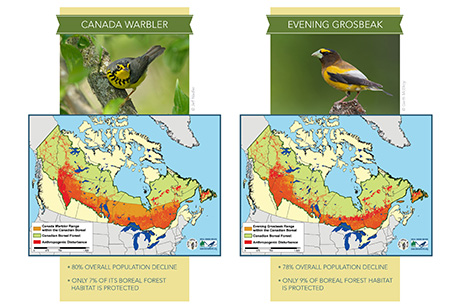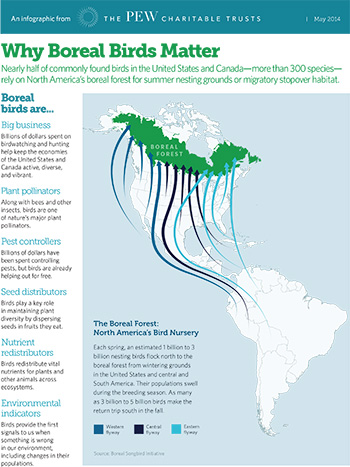Threats seen to 3 billion birds in vast Canadian forest
By Krishna Ramanujan

A new report calls for saving half of the 1.5 billion acres of North America’s boreal forest – one of the world’s last great intact forests – to protect the habitat for more than 300 migratory bird species. The northern landscape is beset with oil, gas, mining and other industrial hazards destined for a vast, pristine woodland.
Stretching from Alaska to Newfoundland, the boreal forest – the circumpolar woods that circle the upper Northern Hemisphere – provides habitat for up to 3 billion nesting and migratory birds, according to the report, “Boreal Birds Need Half: Maintaining North America’s Bird Nursery and Why it Matters,” released May 5 by the Boreal Songbird Initiative, Ducks Unlimited and Ducks Unlimited Canada.
More species have become threatened and endangered due to industrial encroachments into the birds’ habitats. For example, Canada warblers and evening grosbeaks have both recently experienced close to 80 percent declines in numbers, says the report.

The document outlines the economic and ecological importance of these species. For example, birding-related business generates some $100 billion per year in the U.S. and Canada alone, said Jeff Wells, Ph.D. ’96, associate scientist at the Cornell Lab of Ornithology and the report’s lead author.
In the boreal forest, birds play key ecological roles: Nectar-feeding birds pollinate plants; fruit and seed eaters disperse seeds; waterfowl, seabirds, shorebirds and fishing birds redistribute nutrients from water areas and deposit them on land in the form of droppings and food scraps; and they control pests in forests. They serve as environmental indicators of such pollution as chemical contamination and heavy metals, which may affect birds and raise warnings for humans.
While the boreal forest remains one of the largest intact forests on Earth, it is “also seen as the last great frontier for natural resource extraction,” said Wells of the urgency to protect these areas.
Southern boreal forests have already been affected by oil and gas mining, forest product industries, hydropower, and roads and infrastructure.
Currently, Canada is considering usage policies that will affect the remaining intact 70 percent of the boreal area. “Decisions are being made today about what will happen over the next 100 years,” said Wells.
Consumers in the United States can have an impact on policies based on their buying choices, Wells explained, as most of the products borne from the boreal go directly to the U.S., including wood, oil and gas, minerals and hydroelectricity.
Also, the report advocates that all solutions for balancing conservation and development should be made jointly between Canada and indigenous communities and provincial governments, according to the report.
In Canada, most land use decisions are made at the provincial or territorial level, said Wells, adding that hundreds of indigenous communities still live in remote boreal areas, where they rely on the land and water for their survival.
Media Contact
Get Cornell news delivered right to your inbox.
Subscribe